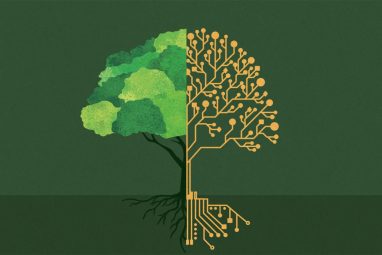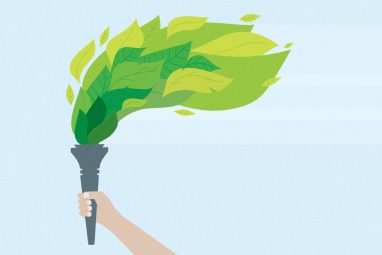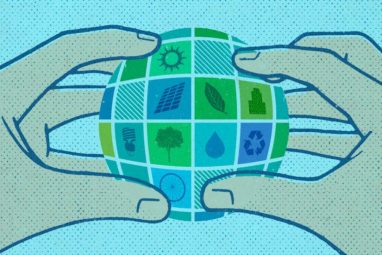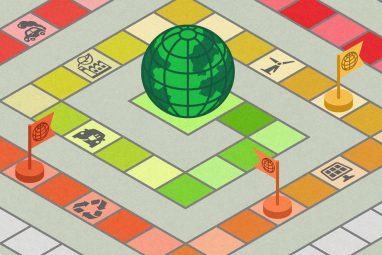Find a Circular Strategy to Fit Your Business Model
Products and services that maximize use and reuse of materials and other resources can be both growth opportunities and sustainability measures.
News
- Core42 and Qualcomm Launch Compass 2.0 to Boost AI Efficiency and Accessibility
- Data Debt Emerges as Core Business Issue for Enterprises
- Are Organizations Investing in AI Achieving Positive ROI?
- Are Increasing Breaches Due to the Cyber Skills Gap?
- What Are the Challenges Firms in the UAE and Saudi Arabia Face in GenAI Implementation?
- Enterprises See the Promise of Generative AI But Lack the Guardrails to Mitigate Operational Risks
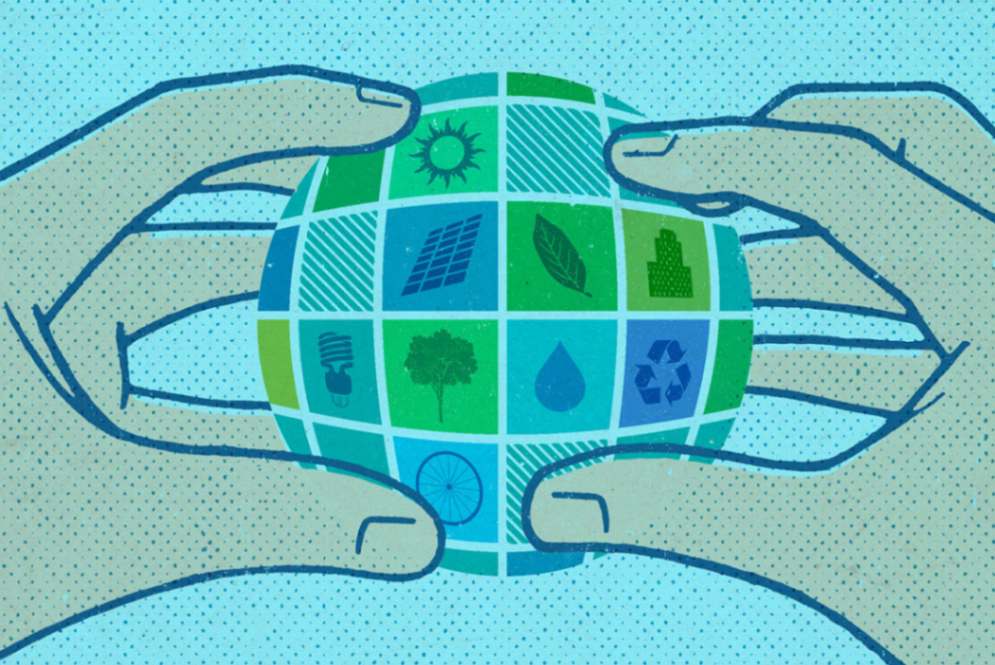
Dan Page/theispot.com
Companies seeking to meet ambitious sustainability goals to reduce fossil fuel consumption and reduce waste must go beyond a shift to renewable energy. Roughly half of global emissions are linked to the production and consumption of goods such as food, packaging, buildings, and textiles.1 Accelerating decarbonization will require that we rethink the materials and services sourced from suppliers, the distribution and use of products by customers, and what happens to products at end of life.
That’s where circular models come into focus. They aim to optimize the use of material resources in organizations and thus help reduce carbon emissions and mitigate strain on natural systems. For businesses, circularity promises to enhance competitiveness by improving bottom lines through resource efficiency and boosting resilience against resource market volatility through closed-loop supply chains. Moreover, compelling circular offerings, such as refurbished furniture or new items made from recycled materials, appeal to customers striving to meet their own sustainability goals.
Despite these advantages, circular businesses remain uncommon, largely due to the challenge of identifying and operationalizing suitable models that align with a firm’s overall strategy and capabilities.2 In this article, we draw on our research into organizations implementing these models to explain four different routes to circularity, and key considerations for effectively implementing them.
The practical principles underlying circular business models can be stated as simple goals: use less, use longer, use again, use differently.3 (See “Four Approaches to Circularity.”) Most circular models emphasize one of these paths, but often in combination with others.
Four Approaches to Circularity
Organizations developing circular business models typically begin with one of the following paths, though they may use several in combination.
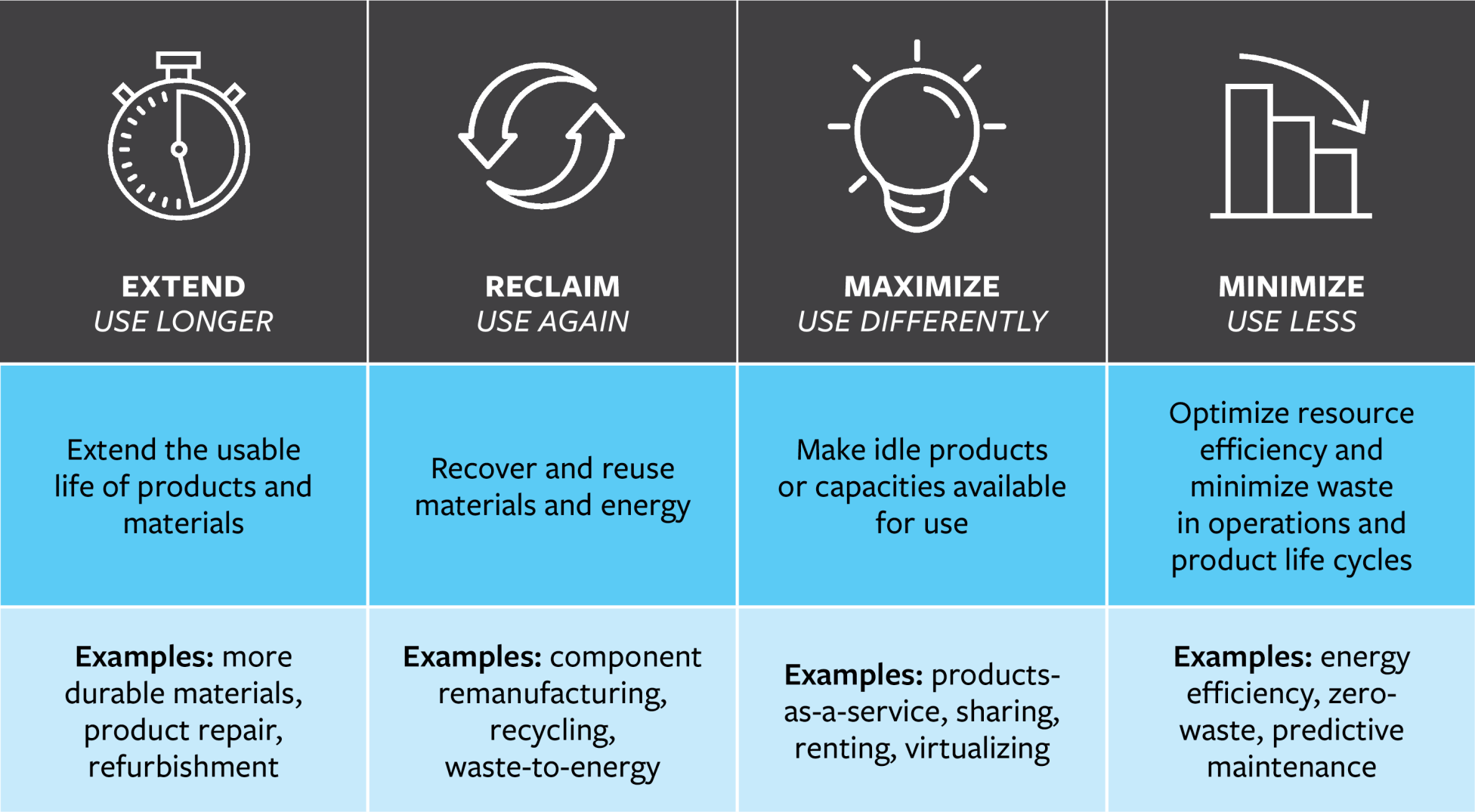
Extend Product Lifespan
Reuse, resale, repair, or refurbishment are among the use-longer tactics that help companies maximize the usable life of products, reducing both waste and consumption of new resources. The challenge for companies that pursue this approach is preserving the benefits customers derive from newly manufactured products. Some ways to operationalize this include the following:
Design products for longevity. To enable repair or refurbishment, products must be designed for durability, modularity, and disassembly. That may require using more durable materials, avoiding adhesives in assembly, and ensuring that standard tools can be used in repairs.
The Dutch Ministry of Defense (MoD) has adopted a circular approach to the uniforms it provides, cleaning and repairing them to extend their usable life. It redesigned uniforms to allow easy replacement of components like damaged sleeves without destroying the whole item. This not only reduced waste but also led to an annual savings of 8 million to 10 million euros that would have been spent on new purchases and disposal.4 Smartphone manufacturer Fairphone similarly designed phones with modular, swappable components. Customers wanting a better camera or battery can simply upgrade those components rather than having to buy a new phone, delaying obsolescence.
Designing for disassembly and repair does involve trade-offs. More durable and modularized components or detachable fasteners can increase manufacturing complexity and cost. Despite the complexities, this approach is a key principle in enabling circular models from electronics to buildings.5
Establish repair and refurbishment capabilities. Extending product lifespans requires building repair and refurbishment capacity, either in-house or through partnerships. The Dutch MoD chose the latter route. With item volumes in the hundreds of thousands, the MoD needed an industrial-scale repair facility. Rather than build it themselves, it partnered with Biga Groep, a social enterprise that provides employment to members of disadvantaged communities. The two parties collaborated to develop industrial-scale repair capabilities. This partnership grew over time as Biga Groep gradually expanded its capabilities, also creating new jobs.
It is crucial that product development teams work closely with those responsible for repair and refurbishment to better understand design requirements for longevity and repair. When shoe manufacturer Vivobarefoot launched a repair and refurbishment program, it learned that its shoes could be difficult to repair. It subsequently started having its design teams engage with repair partners to gain feedback for future product.
Manufacturers must also plan for longer-term availability of spare parts and repair services, including how repair and refurbishment will be provided, such as through expanded warranty plans or as chargeable services that could be additional revenue streams. Buy-back plans can encourage customers to return products to manufacturers for refurbishment and resale.
Depending on the sector, independent companies may already offer resale, repair, and refurbishment services, for example, in the mobile phone market. Manufacturers can support this market with spare parts, repair kits, and manuals. This may become a regulatory requirement under emerging Right to Repair laws across different jurisdictions. For example, the EU’s right to repair rules require manufacturers to make spare parts available for professional repairers for up to 10 years for certain product categories. A looming issue on this front is support for software components in so-called smart products.
Leverage data and digitalization. Data can enable more effective maintenance, repair, and refurbishment. Some manufacturers use internet-connected sensors and predictive analytics to monitor product health and schedule maintenance. Data analysis can also shed light on customer usage, common faults, and wear-and-tear patterns to improve product designs.
Additionally, digital platforms provide a channel for resale of used and refurbished products, especially if supported by comprehensive data on product condition and history, enhancing transparency and trust in the resale market. Brands may find that their used or refurbished products are already available on marketplaces like eBay, Vestiaire Collective, or Back Market.
Reclaim and Regenerate Resources
For companies following the use-again approach to capture value from waste materials, the distinction between technical and biological resources is key. Originally defined in the cradle-to-cradle model,6 biological resources include raw materials such as food, wood, cotton, and other animal or plant-based materials, while technical resources include metals, plastics, synthetic chemicals, and other artificial materials. The two require different approaches.
Because biological resources are in principle renewable, the focus should be on recovering and reusing nutrients to regenerate natural systems and ensure sustainable production. Plant and animal waste can be composted and used to enrich soil health, and biogas can be recovered for energy production through anaerobic digestion.
Remanufacture or recycle technical materials. Metals used in electronic products, such as copper, lithium, aluminum, and gold, could theoretically be reused indefinitely, particularly if recovered into their elemental forms. On the other hand, plastic is a nonrenewable resource, and plastic packaging has limited reuse. A use-again approach through recycling can be a viable option to ensure circularity of technical materials. U.K.-based packaging manufacturer Charpak uses recycled plastic as raw material for its products, which are themselves recyclable.
Turn waste into revenue. Use again can also involve turning waste resources into products through intermediate processing. For example, materials science companies Biohm and Ecovative are using agricultural residues to grow mycelium, the rootlike structures of fungus, as bio-based materials for packaging, fashion, and building materials. Biotech company Entomics Biosystems uses organic waste to cultivate insect larvae, which is turned into a sustainable protein source for animal feed in livestock farming.
Given the vagaries of fashion, unsold inventory can be a significant source of waste for apparel manufacturers. Luxury brand LVMH has spun out a platform, Nona Source, where others can purchase deadstock yarn, fabric, and leather. Aside from avoiding waste, this enables smaller, independent designers to purchase high-quality material that they typically would not have access to. Rype Office remanufactures used office furniture into high-quality, low-carbon products for corporate clients. As furniture makes up to 30% of embodied emissions in commercial buildings, shifting to remanufactured items can help organizations reduce their carbon, resource, and waste footprint.
Design products with recycling in mind. Like use longer, use again starts with product design. Most products today suffer from low recycling rates, and most recycling is really downcycling into lower-quality products, such as garments into rags or insulation materials.
One reason for this is that many products are not designed for recyclability. They are often composed of a mix of materials, each with different degrees of recyclability and requiring different treatment. For example, clothing often contains a mix of natural and synthetic fibers; electronic devices comprise a host of different metals, plastics, glass, and other materials; and packaging frequently includes labels or linings. Ideally, products should be made from single materials, such as mono-fiber textiles or polyethylene terephthalate (PET)-only packaging, although this is often not possible.
Designing for use again involves several approaches. The first step is to maximize the proportion of recycled or regenerative materials that are themselves recyclable or biodegradable in order to reduce the use of virgin materials and production of waste. This includes eliminating toxic elements. For example, flooring company Tarkett’s carpet brand Desso and carpet manufacturer Hook & Loom designed out toxic chemicals and materials that would limit the reusability or biodegradability of their materials.
Designers must also consider disassembly. Just as with use-longer models, products should be designed to be easily taken apart so that components can be remanufactured or recycled. The E.U.-funded Buildings as Material Banks project applied this principle, developing standards and tools such as the Reversible Building Design Protocol so that buildings can be deconstructed to recover and reuse materials.
This design approach will often require development of new materials and processes that meet quality and performance criteria. Charpak addressed this by working with innovation partners on modular design and replacing black plastic with 100% recyclable gray plastic. This required a full life-cycle analysis of product design for recyclability, including considering the post-use phase and managing trade-offs. For example, a certain percentage of virgin material was required to meet functional and aesthetic requirements.
Establish reverse logistics systems and partnerships. Designing circular products does not necessarily result in actual circularity in the absence of effective reverse logistics systems. Modern supply chains are typically optimized for producing and distributing products into the market, with less emphasis on getting products and materials back for reuse. For manufacturers transitioning to a circular model, the challenge extends beyond merely ensuring effective recycling of their products to also guaranteeing certainty of supply of raw materials to create their products.
Accomplishing this may require innovation in the waste-processing segment of the value chain, including technologies and processes for effective collection, sorting, and recycling of waste into new raw materials. In some segments, like post-consumer plastic waste, direct recovery of products can be challenging. Plastics enter the waste management stream and need sorting and processing before they can be reused. Charpak addressed this in the U.K. by partnering with city councils, waste management providers, and reprocessors to establish a local circular plastics loop. Under the Cambridgeshire and Peterborough Waste Partnership (RECAP) program, household plastic waste is collected, sorted, cleaned, and sent to be reprocessed into new materials, which Charpak then sources.
Rype Office grappled with uncertainty in its supply of used furniture, which typically depended on office clearance events. To mitigate this, it established take-back channels in partnership with building retrofitters and offered its customers leasing and buy-back options. For situations where remanufactured furniture is insufficient to meet client demands, Rype Office recommends new pieces that are easily remanufactured over multiple uses, further ensuring future supply.
Maximize Product Use
In many cases, consumers may not feel the need to own a product. Companies can sell access rather than ownership; sharing, renting, and service-based approaches can replace product sales. These models boost circularity by increasing asset utilization and aligning incentives to encourage customers to use less, use longer, and use again. The use-differently approach also can broaden access to products that might otherwise be out of reach for some consumers.
Service-based models come in different forms, such as very short-term rentals of cars (Zipcar) or designer clothing (Rent the Runway), or peer-to-peer platforms like Hello Tractor, which enables farmers to rent idle equipment to other small-scale farmers who can use the machinery to improve crop yields. Another model is providing products-as-a-service, where providers retain ownership and customers pay based on usage. Lighting multinational Signify offers a pay-per-lux service: The company will install, maintain, and decommission lighting equipment, including reuse, repair, and recycling.
Design services based on customer jobs-to-be-done. Identifying the customer’s goals can inspire innovative circular models.7 As Signify illustrates, customers want reliable and efficient lighting, and a “lighting as a service” model both circumvents the complexities of managing assets and reduces capital expenditure on equipment. Similarly, many city dwellers prefer to not own a car, but they occasionally need transport with more flexibility, convenience, and range than a bike, bus, or train. This idea underpins shared mobility models like Zipcar — rather than multiple households owning cars that are infrequently used, customers can access shared cars on demand.
Leverage digital platforms. Hello Tractor’s sharing model illustrates how data, connectivity, and digital platforms can enable sharing, rental, and service models to monitor and optimize assets and connect supply and demand. Hello Tractor’s mobile app connects small farmers with tractor owners to schedule and manage bookings and payments. The company also helps tractor owners outfit their equipment with low-cost internet of things devices to track location, fuel levels, tractor operations, and maintenance needs. That data can support new services such as route optimization for tractor owners and help them to better manage their equipment assets. Importantly, Hello Tractor understands that access to tech is uneven among small farmers, so it also engages local booking agents to help with bookings and aggregate local demand.
Align incentives. Service design critically hinges on aligning incentives between the service provider and the customer around economic, functional, and sustainability factors. To achieve circularity goals, providers and customers must actually use items responsibly and efficiently.
Signify’s lighting-as-a-service contracts include delivery of performance metrics for lighting quality and energy efficiency. Customers are concerned with only the reliability and performance of lighting. Extending the use of equipment and materials through monitoring, durable design, reuse, repair, refurbishment, and recycling saves costs for the provider. A service-based model also facilitates closed-loop reverse logistics systems, as the provider retains control and chain of custody of the assets.
Minimize Resource Use
Figuring out how to use less of any resource should always be a priority when conservation is the objective. With this goal, organizations can think broadly about how they can minimize the use of energy, materials, and water in operations.
Focus on efficiency. Look for practices and technologies that optimize resource use while minimizing waste. Lean manufacturing principles, for instance, can significantly reduce material waste and energy consumption. Designers can experiment with ways to deliver the same value using fewer materials. Additionally, integrating energy-efficient technologies in operations, such as LED lighting or optimized heating and cooling systems, can reduce the environmental footprint significantly.
Efficiency optimization can also be applied to capacity utilization of assets. Shared resources, like coworking spaces or shared manufacturing facilities, can optimize space and equipment use. Designing buildings for reconfigurability can enable flexibility for multiple uses. In logistics, fleet optimization ensures full vehicle loads, reducing the number of trips and thus lowering emissions and costs. Similarly, demand-responsive services like cloud computing can adapt supply efficiently to meet actual demand, avoiding excess capacity.
Design out waste. Naturally, using less begins with product or process design. Consider packaging: Significant efficiencies can be found here before looking at the product itself. U.K. supermarket retailers Tesco and Waitrose, for example, reduced plastic waste by removing plastic wrapping from some multipack food and beverage items. Food technology companies Mori and Apeel Sciences are developing edible coatings that extend the shelf life of produce, replacing plastic packaging. Bulky liquid products that contain a great deal of water, like cleaning or beauty products, can be reformulated as concentrate or tablets. This reduces product size and weight, which lowers the carbon impact of shipping and the cost and footprint of storage and delivery.
Tap data analytics. Insights afforded by digital tools are as important here as they are in other approaches. Advanced data analytics pinpoint ways to minimize resource consumption and waste production. Ikea reduced food waste by 54% in its in-store restaurants by using smart scales and AI to track and analyze food waste. Ikea also partnered with food platform Too Good to Go to further reduce food waste through selling its surplus at discounted prices.
Key Success Factors for Circularity
Numerous opportunities are available for companies to embed circularity into their products and operations. While approaches may vary, our research has found that successful initiatives pay attention to the following factors:
Strategic fit. The cornerstone of circular transformation is how it fits with your business strategy. Identify a model that aligns well with your company’s strategic positioning and brand ethos and leverages core strengths and values. A chosen model should enhance both sustainability and profitability. For example, a luxury brand should provide premium retail experiences for resale, repair, or refurbished offerings.
Committed leadership and circular mindset. Circularity transformation starts with leadership, mindset, and culture. The company’s leadership needs to champion and drive the circularity agenda and provide resources and training to the whole organization. A key lesson is that circularity must go beyond specific initiatives; it requires a mindset where everyone is constantly looking at waste as a valuable resource. Sugar processor British Sugar has turned almost every by-product stream from its beet sugar manufacturing process into inputs for new products, including biofuels and industrial and agricultural products, as well as a new business segment for animal feed.
Combined models. The four models — use less, use longer, use again, and use differently — are not mutually exclusive and should be combined to create viable circular offerings. For example, the Dutch MoD recycles items once they can no longer be repaired. A similar model could be applicable for electric vehicle batteries. With electric cars expected to account for more than two-thirds of global car sales by 2030, pressures will increase from mineral scarcity and electronic waste. A more circular approach could keep batteries in use in vehicles through repair and refurbishment (use longer). Once degraded, used batteries could be remanufactured into energy storage systems for renewable power grids (use differently), and finally recycled to recover materials to make new batteries (use again).
Compelling value proposition. Successful circular offerings must go beyond purely environmental benefits to also meet customer needs such as functionality, desirability, aesthetics, accessibility, and economics. Consider the end-to-end value chain design and trade-offs required to ensure customer acceptance of a circular offering. Rype Office recognized that corporate clients would not compromise on furniture quality and aesthetics for lower carbon options, so it provides interior design services to help clients integrate remanufactured pieces into existing office aesthetics. Hello Tractor’s network of local agents was in part based on user insight on ensuring accessibility and supporting the needs of small farmers.
Value-based collaborations and partnerships. Most companies will struggle to build circular capabilities by themselves. While organizations may embed circular requirements into green procurement criteria, challenges arise when suppliers cannot meet these demands in the short and medium term. A more effective approach may require co-innovation partnerships with suppliers, peers, and other partners. A prime example is Jaguar Land Rover’s RealCar project, where it worked with industrial, academic, and public-sector partners to develop aluminum recycled from postindustrial waste for use in its cars. This required innovation in material chemistry to develop aluminum grades with suitable performance, recyclability, and applicability. A critical key success factor was the approach to collaboration around shared goals for the entire value chain for recycled aluminum.8
Journey of learning and iteration. The circularity transformation should be approached as a journey of learning and iteration. The winning circular models are often not obvious, emerging through experimentation and engagement with customers, suppliers, and other stakeholders. Explore what works and what doesn’t, and adapt strategies based on these findings. Equally important is understanding and managing trade-offs and unexpected consequences that arise. Starting with small-scale pilots allows companies to test ideas in a controlled environment, learn from these experiments, and then scale up successful initiatives, building capabilities over time.
The journey to circular economy models is complex. However, many brands may already have active markets for resale, repair, or refurbishment of their products, as well as potential partners in different sectors. Beyond meeting environmental goals, engaging in circular models offers businesses opportunities to control customer relationships and experiences, gain valuable market insights, and capture additional revenue.

